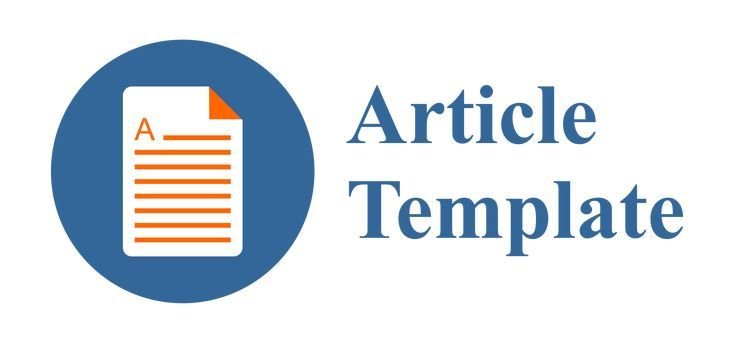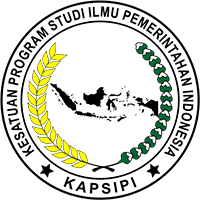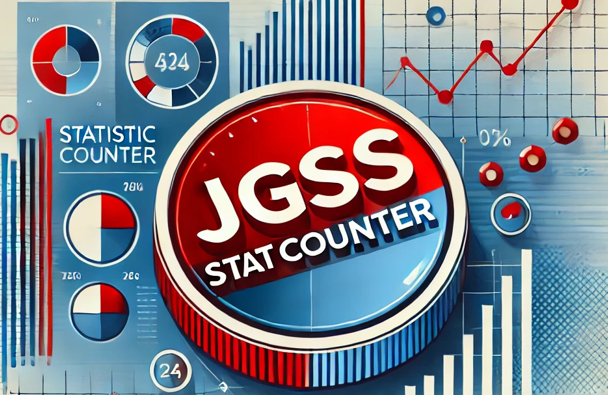The Performance of the Regional Disaster Management Agency of North Maluku Province in Disaster Logistics Distribution Services in Central Halmahera Regency
Abstract
The purpose of this research is to understand and explain the performance of the BPBD of North Maluku Province in the logistics distribution service in Messa Village and Kotalo Village, East Weda District, Central Halmahera Regency. This research uses a qualitative descriptive method aimed at describing events or activities within an institution and then elaborating on the issues being studied through several relevant indicators. Data collection techniques through; observation, interviews, documentation, data analysis techniques through; data reduction, data presentation, and conclusion, drawing, or verification. Based on the research results; first, the productivity of the BPBD of North Maluku Province in the logistics distribution service in Messa and Kotalo Villages has not been effectively implemented due to limited resources, Second, the quality of service has not been optimally carried out because the distribution of logistics does not yet have SOPs that are by field conditions, and the logistics distribution in terms of timeliness is still not appropriate because it takes about 4 days to reach the disaster-affected location. Third, the responsiveness of the BPBD of North Maluku Province in the logistics distribution service process in Messa Village and Kotalo Village has been very good. The team from the BPBD of North Maluku Province consistently responds well to the needs of the disaster-affected community, and fourth, the accountability of the BPBD of North Maluku Province's performance has been carried out and accounted for by the regulations and is reported through SAKIP and LKIP.
Downloads
References
Al-Hamdi, Ridho, Sakir, Suswanta, Muhammad Eko Atmojo, And David Efendi. (2020). Penelitian Kualitatif: Pegangan Mahasiswa Ilmu Pemerintahan. Yogyakarta: Pustaka Pelajar.
Andriansyah, Andriansyah; Sentia, Prima Denny. (2018). Penentuan rute kendaraan pada sistem distribusi logistik pasca bencana (studi kasus). Jurnal Manajemen Industri dan Logistik, 2.1: 79-89.
Asiah, N. (2023). Analisis Pelaksanaan Manajemen Logistik Dan Peralatan Penanggulangan Bencana Di Bpbd Kabupaten Bone Bolango. Publik: Jurnal Manajemen Sumber Daya Manusia, Administrasi dan Pelayanan Publik, 10(4), 1124-1134.
Buchari Zainun. (1989). Manajemen Dan Motivasi: Balai Aksara Jakarta.
Bowersox, D. J. Manajemen Logistik: Integrasi Sistem-Sistem Manajemen Distribusi Fisik dan Manajemen Material. Jakarta: Bumi Aksara. 2002.
Carnero Quispe, M. F., Couto, A. S., de Brito Junior, I., Cunha, L. R. A., Siqueira, R. M., & Yoshizaki, H. T. Y. (2024). Humanitarian logistics prioritization models: a systematic literature review. Logistics, 8(2), 60.
Darmawan, B., Okitasari, H., Dwiyanti, V., Pratama, P. Y., & Haritman, E. (2024). Preliminary research: Blockchain system design for post-disaster management in Indonesia. Journal of Engineering Science and Technology, 19(4), 1268-1279.
Erden, C., Ateş, Ç., & Esen, S. (2024). Distribution center location selection in humanitarian logistics using hybrid BWM–ARAS: a case study in türkiye. Journal of Homeland Security and Emergency Management, 21(3), 383-415.
Dwiyanto, Agus (2006). Mewujudkan Good Geovernance Melalui Pelayanan Public. Yogyakarta: UGM Press.
Fazli, L., Salari, M., & Neghabi, H. (2024). A location-inventory-distribution model under gradual injection of pre-disaster budgets with application in disaster relief logistics: a case study. Soft Computing, 28(3), 2125-2159.
Ghelichi, Z., Gentili, M., & Mirchandani, P. B. (2022). Drone logistics for uncertain demand of disaster-impacted populations. Transportation research part C: emerging technologies, 141, 103735.
Hendrayana, A. (2024). Implementasi Perancangan Sistem Informasi Bantuan dan Distribusi Logistik dalam Upaya Tanggap Bencana di Kabupaten Garut. Jurnal Algoritma, 21(2), 396-404.
Hellingrath, B., dan Widera, A., 2011. Survey on Major Challenges in Humanitarian Logistics. Proceedings of the 8th International ISCRAM Conference,
Hidayat, M., & Akbar, A. (2024). Community-Based Disaster Communication In The Emergency Response Phase Of The Eruption Of Mount Lewotobi Men, East Flores. Jurnal Cahaya Mandalika ISSN 2721-4796 (online), 5(2), 713-719.
Habeahan, E. O., & Amin, M. M. (2024). Manajemen Logistik Bantuan Bencana Banjir Oleh Dinas Sosial Kabupaten Mimika Provinsi Papua Tengah (Doctoral Dissertation, IPDN).
Idrus, Muhammad (2009). Metode Penelitian Ilmu Sosial. Yogyarkarta: Erlangga
Isya, M., Saleh, S. M., Rahmat, Y., & Refiyanni, M. (2021). Analisis Deskriptif Efektifitas Distribusi Logistik Pasca Bencana Gempa Bumi di Pidie Jaya. Jurnal Teknik Sipil dan Teknologi Konstruksi, 7(2).
Judijanto, L., Asniar, N., Kushariyadi, K., Utami, E. Y., & Telaumbanua, E. (2024). Application of integrated logistics networks in improving the efficiency of distribution and delivery of goods in indonesia a literature review. Sciences du Nord Economics and Business, 1(01), 01-10.
Koç, M., & Sarıkaya, H. A. (2024). Maximal covering method in determining distribution centers in disaster logistics. Endüstri Mühendisliği, 35(1), 22-60.
Kundu, T., Sheu, J. B., & Kuo, H. T. (2022). Emergency logistics management—Review and propositions for future research. Transportation research part E: logistics and transportation review, 164, 102789.
Li, S., & Zhou, Y. (2024). Integrating equity and efficiency into urban logistics resilience under emergency lockdowns. Transportation Research Part E: Logistics and Transportation Review, 183, 103446.
Moleong, Lexy J. (2010). Metode Penelitian Kualitatif. PT Remaja Rosdakarya: Bandung.
Mahmudi. (2010). Manajemen Kinerja Sektor Publik. Penerbit UUP STIM YKPN, Yogakarta
Murdijanto P, (2001) ; Dasar-Dasar Manajemen. Penerbit Grafindo Persada, Cetakan Kelima, Jakarta.
Rukin. (2019). Metodologi Penelitian Kualitatif. Sulawesi Selatan: Yayasan Ahmar Cendekia Indonesia.
Rivai, (2005).” Manajemen Personalia dan Sumber Daya Manusia”, Yogyakarta.
Ruky S. Achmad. (2001) Sistem Manajemen Kinerja. PT Gramedia, Jakarta.
Suwendra, I. W. (2018). Metodologi Penelitian Kualitatif: Dalam Ilmu Sosial, Pendidikan, Kebudayaan, Dan Keagamaan. Bali: Nilacakrala.
Sari, W. M. (2024). Logistics Management Of Flood Disasters By The Regional Disaster Management Agency (BPBD). Journal of Small and Medium Enterprises, 3(2).
Sedarmayanti. (2014). Manajemen Sumber Daya Manusia. Cetakan Ke-7. Bandung : Refika Aditama
Tika, Moh. Pabundu, 2011, Budaya Organisasi Dan Peningkatan Kinerja Perusahaan. Jakarta: Penerbit PT Bumi Aksara,
Tarei, P. K., Gumte, K. M., Patnaik, J., & Oktari, R. S. (2024). Analysing barriers to humanitarian logistics for distributing relief aid in pre-and post-disaster situations. International Journal of Disaster Risk Reduction, 104, 104388.
Tuakora, S. C., Rolobessy, M. J., & Rukoyah, R. (2024). Pemenuhan Aksesibilitas Pelayanan Publik Bagi Penyandang Disabilitas Di Kecamatan Baguala Kota Ambon. Journal of Government Science Studies, 3(2), 77-84.
Thomas, A., Kopczak L. (2005). From Logistics to Supply Chain Management. The Path Forward in the Humanitarian Sector. San Francisco: Fritz Institute.
Uno. B.Hamzah. (2012). Teori Kinerja Dan Pengukurannya , Jakarta, Bumi Aksara
Ummal, A., & Wicaksana, D. D. (2020). RANCANGAN SISTEM INFORMASI LOGISTIK KEBENCANAAN: Studi Kasus: Badan Penanggulangan Bencana Daerah Jawa Barat. METHOMIKA: Jurnal Manajemen Informatika & Komputerisasi Akuntansi, 4(1), 37-42.
Una, Sayuti, (2014). Pedoman Penulisan Skripsi Edisi Revisi (Jambi: Syariah Press Fakultas Syariah IAIN Sulthan Thaha Saifuddin Jambi).
Wibowo. (2008). Manajemen Kinerja. Jakarta : PT.Raja Grafindo Persada Winardi, 1992, Manajemen Kepegawaian, Jakarta; Gunung Agung
Hadiguna, R. A., & Wibowo, A. (2012). Model Dinamika Sistem Logistik Bantuan Pasca Bencana Gempa Bumi–Tsunami di Kota Padang. In Seminar Nasional Teknologi Informasi Komunikasi dan Industri.
Singh, J., & Jaggi, C. K. (2024). Integrated optimization of humanitarian relief chains: a multi-product nonlinear programming approach for disaster logistics under uncertainty. International Journal of System Assurance Engineering and Management, 1-21.
Sahilala, Ischa Mabruris. (2005). Tata Kelola Distribusi Bantuan Logistik Korban Bencana Alam (Studi Empiris pada Bencana Banjir di Kabupaten Bojonegoro). Diss. Brawijaya University.
Widiya, D. (2024). Responsivitas Badan Penanggulangan Bencana Daerah Dalam Menanggulangi Bencana Banjir Di Kabupaten Aceh Tamiang (Doctoral Dissertation, Universitas Malikussaleh).
Wang, S., Guo, L., Wang, M., & Han, Y. (2024, October). Optimization of Post-Disaster Logistics in Flood Response Considering Collaboration of Electric Truck and Drones Charging. In 2024 IEEE Transportation Electrification Conference and Expo, Asia-Pacific (ITEC Asia-Pacific) (pp. 293-298). IEEE.
Yulianto, A. (2024). Analisis Kualitas Pelayanan Publik Penanggulangan Bencana Bpbd Kota Semarang.
Zahra, A. F., Yulianti, F., & Kusuma, P. G. A. (2024). Penentuan Lokasi Optimal Gudang Bantuan Logistik Wilayah Jawa Barat Menggunakan Metode Maximal Covering Location Problem (MCLP). eProceedings of Engineering, 11(4), 4484-4494.

Copyright (c) 2025 Bakri La Suhu, Darwin Abd Radjak, Abdul Halil Hi Ibrahim, M. Rizki Rahadi

This work is licensed under a Creative Commons Attribution-ShareAlike 4.0 International License.







.png)





